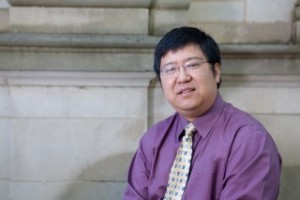Nov 14 2014
Engineering researchers at the University of Arkansas and their colleague at the University of Arkansas at Pine Bluff have received a $725,000 grant from the U.S. Air Force Office of Scientific Research to further develop a new material for advanced electronics devices.
 Fisher Yu, University of Arkansas. (Credit:University of Arkansas)
Fisher Yu, University of Arkansas. (Credit:University of Arkansas)
Mansour Mortazavi, a professor of physics at the University of Arkansas at Pine Bluff and the grant’s principal investigator, is collaborating on the project with University of Arkansas electrical engineers Fisher Yu and Hameed Naseem.
The material – a combination of silicon, germanium and tin grown on silicon substrates – will create a so-called silicon optoelectronics “superchip” by improving processing speed and reliability through combining photonic and silicon devices. The technology will improve lasers, detectors and cameras.
Photonics is the science of all things related to light, including generation, emission, transmission and sensing. Optoelectronics focuses on the development of electronic devices that source, detect and control light.
“The demonstration of key applications of our research will generate critical momentum toward the advancement of this new material and will radically change the landscape of optoelectronics research,” Yu said. “It will eventually lead to the emergence of a new field of silicon-based, integrated optoelectronics.”
The researchers have already demonstrated the efficacy of silicon-germanium-tin as a powerful semiconductor, one that addresses the problem of so-called “band gap indirectness,” which, in semiconductor physics, has to do with the momentum of electrons in various energy bands. This problem leads to inefficiencies because photons cannot be emitted in an indirect gap.
The researchers will grow and characterize silicon-germanium-tin materials on silicon substrates through a process called ultra-high-vacuum chemical vapor deposition, which is possible because of sophisticated equipment and machines in laboratories directed by Yu and Naseem. Other primary tasks include development of germanium tin detectors and lasers and the establishment of a research consortium.
The project includes funding for three positions, a postdoctoral researcher at the University of Arkansas at Pine Bluff and a doctoral and master’s student at the University of Arkansas.
Yu is an associate professor of electrical engineering and Naseem is a professor of electrical engineering.